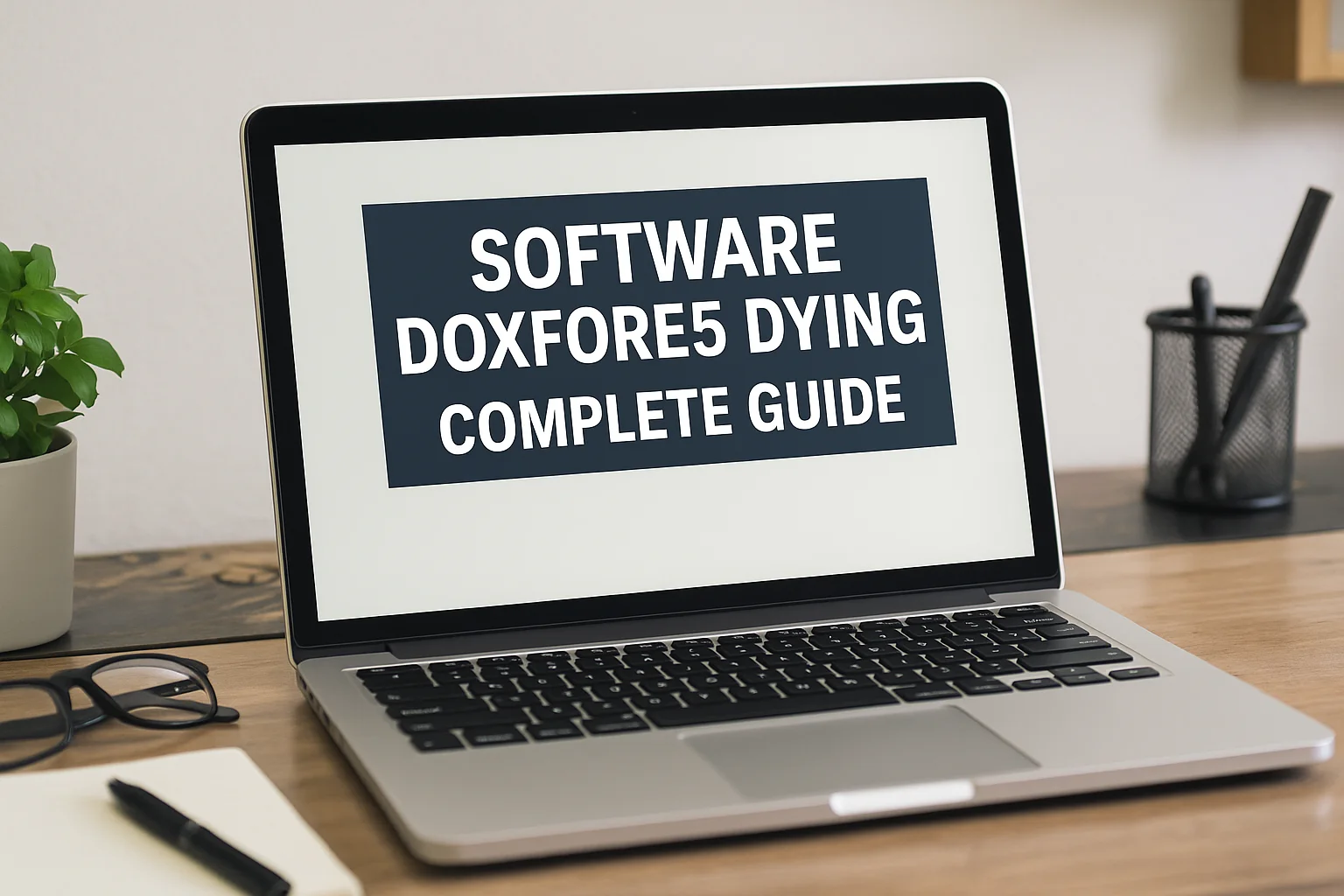Introduction to Doxfore5 and Its Impact
Software Doxfore5 Dying Doxfore5 is a software application designed to streamline document management and enhance collaborative efforts within various organizational settings. Launched in the early 2010s, it quickly gained traction among businesses and educational institutions seeking to improve the efficiency of their operations. This tool allows users to create, edit, and share documents in an integrated environment, facilitating real-time collaboration and ensuring easy access to important information.
The software is primarily used by professionals in fields such as education, corporate management, and project development, capitalizing on its user-friendly interface and customizable features. Doxfore5’s functionality extends beyond mere document creation; it incorporates data visualization tools, version control, and cloud integration, making it a versatile choice for many users. Its ability to accommodate diverse workflows has solidified its position in the competitive landscape of document management solutions.
However, Doxfore5 is not without its controversies. Over the years, it has come under scrutiny for various reasons, including privacy concerns and questions regarding data security. The perception of Doxfore5 as a potentially vulnerable platform has sparked debates about its reliability compared to other more established tools in the market. Additionally, some users have expressed dissatisfaction with the software’s performance, citing instances of slow load times and functionality issues during peak usage hours. These controversies have drawn attention from both advocates and critics, leading to divided opinions on the tool’s overall value and relevance in today’s fast-paced digital environment.
As discussions surrounding the future of Doxfore5 amplify, examining its inception, primary functions, and the user base it attracted becomes crucial. This analysis will help clarify whether Doxfore5 is indeed facing a decline or if it still holds significance in the software landscape.
Examining the Decline: Reasons Behind the Rumors
The discussion surrounding whether software Doxfore5 is dying has gained traction due to multiple factors influencing its performance and usage. Firstly, market trends indicate significant shifts in the user landscape. The rise of alternative tools that offer similar functionalities has weakened Doxfore5’s market share. Competitors have developed robust features that not only attract existing users but also appeal to new customers. This shift exemplifies a growing preference for modern solutions that promise enhanced security and user experience.
User engagement statistics further paint a concerning picture. Recent analysis shows a decline in active users of Doxfore5, which has generated speculation regarding the software’s sustainability. Increased rates of user churn can often signal dissatisfaction or a search for superior alternatives. Feedback from the user community suggests that many individuals are frustrated with the software’s performance issues, prompting them to migrate to rival platforms that promise better reliability.
Operational challenges also contribute to the claims of Doxfore5’s potential decline. Maintaining software in a rapidly evolving tech environment requires constant updates and adaptations. If Doxfore5 has encountered difficulties in scaling its operations or integrating new technologies, this may hinder its ability to compete effectively. Additionally, legal pressures surrounding data privacy and cybersecurity have put numerous applications under scrutiny, affecting user trust and, consequently, user retention rates.
Public perception plays a crucial role in the viability of any software, and recent shifts in community support are notable. Once perceived as an innovative solution, Doxfore5 is now increasingly viewed with skepticism. As discussions around the software’s relevance continue, it becomes essential to investigate these trends to understand the overall narrative: is Doxfore5 truly dying, or is it simply evolving amidst intense competition and changing user needs?

Comparative Analysis: Doxfore5 vs. Current Alternatives
The landscape of software solutions has continuously evolved, prompting users to explore various alternatives to tools like Doxfore5. In comparing Doxfore5 with its current competitors, several key factors such as features, pricing, and user satisfaction emerge as critical points of distinction.
One prominent competitor to Doxfore5 is Altsoft, which has garnered a substantial user base through its versatile features and user-friendly interface. Altsoft offers real-time collaboration capabilities and advanced data analytics tools, enhancing its appeal for businesses requiring immediate insights and teamwork. Additionally, Altsoft provides flexible pricing plans that cater to different budgetary requirements, something many users appreciate compared to Doxfore5, which has had a more rigid pricing structure.
Another alternative is TechSuite, renowned for its robust customer support and a rapidly growing community of users. The software’s modular design allows users to customize their experience, selecting only the features they need. Unlike Doxfore5, which follows a more traditional software model, TechSuite’s cloud-based approach has resonated well with users seeking scalability and accessibility across various devices. This technological advancement marks a significant shift that could potentially position TechSuite ahead of Doxfore5 in the marketplace.
Moreover, the user feedback regarding efficiency and performance often leans towards these alternative software solutions. Many users have reported improved workflow and integration capabilities with tools like Altsoft and TechSuite, indicating a shift in user preferences driven by technology’s progression. The demand for automation and seamless integration with existing systems appears to overshadow what Doxfore5 currently offers.
In this dynamic environment, Doxfore5 faces considerable challenges. While it maintains a loyal user base, the question remains: Can Doxfore5 adapt to the shifting demands of its users, or is it on the verge of decline? Understanding these parameters will be essential in determining the future viability of software like Doxfore5 amidst rising competition.
The Future of Doxfore5: Possibilities and Predictions
As the digital landscape continues to evolve, the fate of tools like Doxfore5 remains uncertain. With growing concerns about its longevity, many experts are contemplating the potential paths forward for this controversial software. To ascertain whether Doxfore5 is indeed ‘dying’ or has the potential for rejuvenation, it is essential to analyze various factors, including updates, community engagement, and the influence of technological advancements.
One compelling avenue for revitalizing Doxfore5 could be through targeted software updates. Maintaining relevance in a rapidly changing market is crucial, and regular updates that address performance issues, security vulnerabilities, and user interface improvements may attract users who have drifted towards competing platforms. Furthermore, by incorporating user feedback into these updates, Doxfore5 can demonstrate its commitment to catering to its audience, thereby strengthening its user base.
Software Doxfore5 Dying Community engagement also plays a pivotal role in determining the future of Doxfore5. By fostering a vibrant community where users can share their experiences, provide feedback, and contribute to discussions, the software can leverage collective insights for enhancements. Active user forums or social media campaigns could serve as platforms for generating buzz and reviving interest. In addition, soliciting input from industry experts may help guide strategic direction, ensuring Doxfore5 remains aligned with current market demands.
Lastly, the evolving nature of technology and user needs must be accounted for in any forward-thinking strategy. As industries adopt new technologies, Doxfore5 can innovate by integrating these advances to offer improved functionality and relevance. The urgent need for software that efficiently meets user demands suggests that Doxfore5 could either adapt and thrive or continue on its downward trajectory.
In conclusion, while there are legitimate concerns regarding the sustainability of software Doxfore5, a strategic focus on updates, user community engagement, and technological adaptation could present opportunities for future success. The coming years will be critical in determining whether Doxfore5 is indeed ‘dying’ or poised for a resurgence.












Leave a Reply